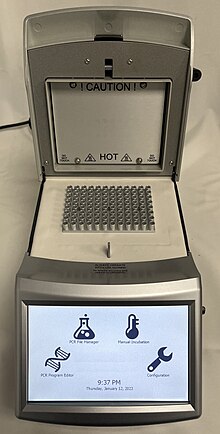72:
80:
142:
20:
124:
blocks to achieve fast temperature changes and uniform temperature throughout the block. Other cyclers have multiple blocks with high heat capacity, each of which is kept at a constant temperature, and the reaction tubes are moved between them by means of an automated process. Miniaturized thermal
149:
Modern thermal cyclers are equipped with a heated lid that presses against the lids of the reaction tubes. This prevents condensation of water from the reaction mixtures on the insides of the lids. Traditionally, a layer of
213:
Higgins, James A.; Nasarabadi, Shanavaz; Karns, Jeffrey S.; Shelton, Daniel R.; Cooper, Mary; Gbakima, Aiah; Koopman, Ronald P. (1 August 2003). "A handheld real time thermal cycler for bacterial pathogen detection".
102:. Since this enzyme is destroyed during each heating step of the amplification process, new enzyme had to be added every cycle. This led to a cumbersome machine based on an automated
116:, which greatly simplified the design of the thermal cycler. While in some old machines the block is submerged in an oil bath to control temperature, in modern PCR machines a
63:
with holes where tubes holding the reaction mixtures can be inserted. The cycler then raises and lowers the temperature of the block in discrete, pre-programmed steps.
165:
function to allow for different temperatures in different parts of the block. This is particularly useful when testing suitable annealing temperatures for PCR
154:
was used for this purpose. Some thermal cyclers are equipped with a fully adjustable heated lid to allow for nonstandard or diverse types of PCR plasticware.
290:
71:
130:
295:
55:(PCR). Thermal cyclers may also be used in laboratories to facilitate other temperature-sensitive reactions, including
241:
125:
cyclers have been created in which the reaction mixture moves via channel through hot and cold zones on a
83:
A very early PCR machine which, rather than cycling through different temperatures, uses three different
166:
186:
Weier, HU; Gray, JW (Jul–Aug 1988). "A programmable system to perform the polymerase chain reaction".
158:
52:
212:
275:
84:
8:
133:
have optical systems which enable fluorescence to be monitored during reaction cycling.
56:
227:
195:
112:
223:
99:
157:
Some thermal cyclers are equipped with multiple blocks allowing several different
79:
117:
95:
107:
106:, with open reaction tubes. Later, the PCR process was adapted to the use of
284:
126:
199:
141:
151:
88:
44:
103:
75:
Baby Blue, a prototype automated thermal cycler built around 1986
87:
at constant temperatures between which samples are moved with a
121:
19:
94:
The earliest thermal cyclers were designed for use with the
161:
to be carried out simultaneously. Some models also have a
48:
120:
is commonly used. Quality thermal cyclers often contain
242:"The Most "Advanced" Thermal Cycler Yet - Get Informed"
269:
47:
apparatus most commonly used to amplify segments of
59:digestion or rapid diagnostics. The device has a
282:
185:
16:Laboratory equipment for cycling temperature
140:
78:
70:
18:
291:Molecular biology laboratory equipment
283:
136:
272:, an open-source PCR thermal cycler
129:chip. Thermal cyclers designed for
13:
14:
307:
276:PCR Machine Service Provider (UK)
263:
234:
206:
179:
1:
228:10.1016/S0956-5663(02)00252-X
216:Biosensors and Bioelectronics
172:
188:DNA (Mary Ann Liebert, Inc.)
7:
108:thermostable DNA polymerase
10:
312:
66:
296:Polymerase chain reaction
53:polymerase chain reaction
145:A Multi Bay PCR Machine
146:
91:
76:
24:
144:
82:
74:
22:
23:A Modern PCR Machine
147:
92:
77:
57:restriction enzyme
25:
137:Modern innovation
113:Thermus aquaticus
31:(also known as a
303:
257:
256:
254:
253:
238:
232:
231:
222:(9): 1115–1123.
210:
204:
203:
183:
131:quantitative PCR
100:DNA polymerase I
311:
310:
306:
305:
304:
302:
301:
300:
281:
280:
266:
261:
260:
251:
249:
240:
239:
235:
211:
207:
184:
180:
175:
139:
118:Peltier element
96:Klenow fragment
69:
17:
12:
11:
5:
309:
299:
298:
293:
279:
278:
273:
265:
264:External links
262:
259:
258:
233:
205:
177:
176:
174:
171:
138:
135:
68:
65:
29:thermal cycler
15:
9:
6:
4:
3:
2:
308:
297:
294:
292:
289:
288:
286:
277:
274:
271:
268:
267:
247:
243:
237:
229:
225:
221:
217:
209:
201:
197:
193:
189:
182:
178:
170:
168:
164:
160:
155:
153:
143:
134:
132:
128:
123:
119:
115:
114:
109:
105:
101:
97:
90:
86:
81:
73:
64:
62:
61:thermal block
58:
54:
50:
46:
42:
41:DNA amplifier
38:
34:
30:
21:
250:. Retrieved
248:. 2014-09-29
246:Get Informed
245:
236:
219:
215:
208:
194:(6): 441–7.
191:
187:
181:
162:
156:
148:
127:microfluidic
111:
93:
60:
40:
36:
33:thermocycler
32:
28:
26:
152:mineral oil
89:robotic arm
85:water baths
37:PCR machine
285:Categories
252:2017-05-31
173:References
45:laboratory
163:gradient
104:pipettor
51:via the
270:OpenPCR
200:3203600
167:primers
67:History
43:) is a
198:
122:silver
110:from
196:PMID
159:PCRs
27:The
224:doi
98:of
49:DNA
39:or
287::
244:.
220:18
218:.
190:.
169:.
35:,
255:.
230:.
226::
202:.
192:7
Text is available under the Creative Commons Attribution-ShareAlike License. Additional terms may apply.



